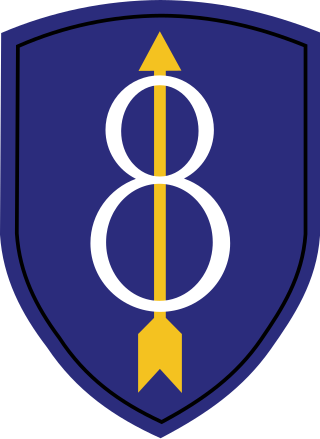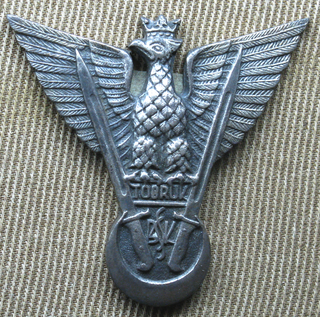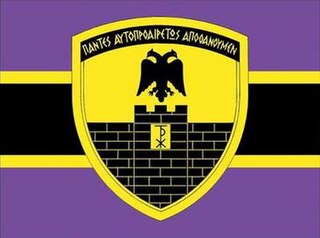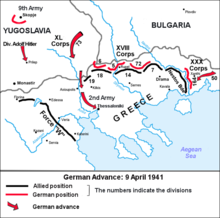
The VII Army Corps of the United States Army was one of the two principal corps of the United States Army Europe during the Cold War. Activated in 1918 for World War I, it was reactivated for World War II and again during the Cold War. During both World War II and the Cold War it was subordinate to the Seventh Army, or USAREUR and was headquartered at Kelley Barracks in Stuttgart, West Germany, from 1951 until it was redeployed to the US after significant success in the Gulf War in 1991, then inactivated in 1992.
The South African 2nd Infantry Division was an infantry division of the army of the Union of South Africa during World War II. The division was formed on 23 October 1940 and served in the Western Desert Campaign and was captured by German and Italian forces at Tobruk on 21 June 1942. The remaining brigade was re-allocated to the South African 1st Infantry Division.

The 8th Infantry Division, ("Pathfinder") was an infantry division of the United States Army during the 20th century. The division served in World War I, World War II, and Operation Desert Storm. Initially activated in January 1918, the unit did not see combat during World War I and returned to the United States. Some units would serve in the American Expeditionary Force to Siberia. Activated again on 1 July 1940 as part of the build-up of military forces prior to the United States' entry into World War II, the division saw extensive action in the European Theatre of Operations. Following World War II, the division was moved to West Germany, where it remained stationed at the Rose Barracks in Bad Kreuznach until it was inactivated on 17 January 1992.

The 27th Infantry Division was a unit of the Army National Guard in World War I and World War II. The division traces its history from the New York Division, formed originally in 1908. The 6th Division designation was changed to the 27th Division in July 1917.

The German invasion of Greece, also known as the Battle of Greece or Operation Marita, were the attacks on Greece by Italy and Germany during World War II. The Italian invasion in October 1940, which is usually known as the Greco-Italian War, was followed by the German invasion in April 1941. German landings on the island of Crete came after Allied forces had been defeated in mainland Greece. These battles were part of the greater Balkans Campaign of the Axis powers and their associates.

Polish Independent Carpathian Brigade was a Polish military unit formed in 1940 in French Syria composed of Polish soldiers exiled after the invasion of Poland in 1939 as part of the Polish Army in France. It was commanded by General Stanisław Kopański.
The Bulgarian First Army was a Bulgarian field army during the Balkan Wars, World War I and World War II.

The Ardennes Counteroffensive, commonly known as the Battle of the Bulge, was a massive military operation undertaken by Nazi Germany in southern Belgium and northern Luxembourg which lasted from 16 December 1944 until 25 January 1945. The intent of the offensive was to split the ground forces of the Western Allies from each other and encourage them to make peace with Germany, leaving all of Germany's military might to fight off the resurgent USSR.

The IV Army Corps "Thrace" is an army corps of the Hellenic Army. Established before the First World War, it served in all conflicts Greece participated in until the German invasion of Greece in 1941. Re-established in 1976, it has been guarding the Greco-Turkish land border along the Evros River, and is the most powerful formation in the Hellenic Army.

The 12th Mechanized Infantry Division "Evros" is a military formation of the Hellenic Army, based at Alexandroupoli, Thrace.

The 16th Mechanized Infantry Division "Didymoteicho" is a mechanized infantry division of the Hellenic Army.

The Belgrade offensive or the Belgrade strategic offensive operation was a military operation during World War II in Yugoslavia in which Belgrade was liberated from the German Wehrmacht through the joint efforts of the Soviet Red Army, Yugoslav Partisans, and the Bulgarian Army. Soviet forces and local militias launched separate but loosely cooperative operations that undermined German control of Belgrade and ultimately forced a retreat. Martial planning was coordinated evenly among command leaders, and the operation was largely enabled through tactical cooperation between Josip Broz Tito and Joseph Stalin that began in September 1944. These martial provisions allowed Bulgarian forces to engage in operations throughout Yugoslav territory, which furthered tactical success while increasing diplomatic friction.
The following is the order of battle of the Hellenic Army during the First Balkan War of 1912–1913.

The Battle of the Metaxas Line, also known in Greece as the Battle of the Forts, was the first battle during the German invasion of Greece in World War II. The Germans succeeded in capturing several individual forts but failed to breach the fortified Metaxas Line in general. The 2nd Panzer division with an enveloping move crossed the Yugoslavian borders, overcame Yugoslav and Greek resistance and captured Thessaloniki on the 9th of April. The capture of Thessaloniki forced the Greek East Macedonia Army Section to surrender on the 10th of April and the Metaxas Line battle was over.

The Battle of Kleisoura Pass took place from the evening of 13 April 1941, when first contact was made, until the midday of 14 April, when Greek organized resistance collapsed. The battle was fought over the narrow pass that crosses between Mt. Vitsi and Mt. Siniatsiko, between elements of the Greek 20th Infantry Division which were occupying the pass and the German Leibstandarte SS Adolf Hitler, a mechanized infantry unit of brigade level. The pass was strategically important for it stood on the main Allied defensive line, behind which passed the withdrawal route of the Greek army engaged against the Italians in Albania.

The III Army Corps was one of three corps the Italian Army fielded during the Cold War. Based in the regions of Lombardy and Piedmont the corps was the army's operational reserve, while the 4th Alpine Army Corps and the 5th Army Corps, both based in the North East of Italy, were the army's front-line units. After the end of the Cold War the corps was reduced in size and on 1 December 2000 it ceded its last brigades to the 1st Defence Forces Command. The personnel of the 3rd Army Corps was used to raise the NATO Rapid Deployable Italian Corps in January 2001.
The 20th Infantry Division was a short-lived formation of the Hellenic Army. It was founded on 24 January 1941, when Greece was already embroiled in the Greco-Italian War.

The 11th Infantry Division was an infantry division of the Hellenic Army.
The 19th Mechanized Division was a mechanized infantry division of the Hellenic Army, established on 15 January 1941. Its formation was not completed until late March. Its nucleus was the pre-war Mechanized Cavalry Regiment, augmented with captured Italian tankettes and cars, motorcycles and Universal Carriers provided by the British. Although officially a "mechanized" unit, as the division was mostly truck-borne, it is usually called the 19th Motorized Division in English-language literature.
The Central Macedonia Army Section was an army corps-level command of the Hellenic Army established on 6 March 1941. It was commanded by Lt. General Ioannis Kotoulas and comprised the 12th Infantry Division and the 20th Infantry Division. On 28 March it was assigned to Henry Maitland Wilson's 'W' Force, holding the Vermion Mountains–Haliacmon line. It was defeated and dissolved in mid-April 1941 during the German invasion of Greece.














